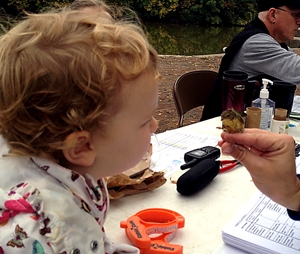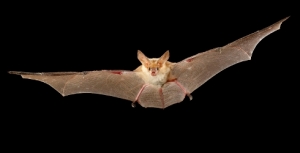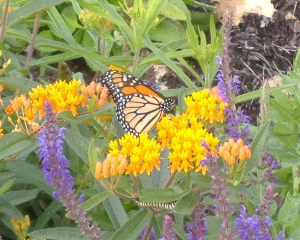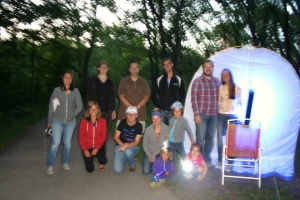
Native Animal of the Month: Common Snapping Turtle
I once found a frozen snapping turtle in a river. He lay motionless under a sheet of ice still looking very much alive. His long tail and thick neck were unmistakable through the blurry ice. The image served as a reminder of the difficulty of being a wild animal living in a Wisconsin winter: an unfortunate casualty of harsh sub-degree temperatures, unable to find a nourishing morsel when most needed. A short-time after encountering the turtle, I investigated how turtles survive the winter. I was surprised to read that turtles can live motionless under the ice by going into a type of hibernation. Alas, the turtle I had encountered earlier in the winter hadn't been dead, but had been peacefully passing the winter in the unfrozen water just beneath the ice! A slowed heart rate, a drop in body temperature, a winter of no breaths; what a risky and remarkable winter adaptation this creature experiences!
Research Lecture Series
2014 - 2015 Season
The Urban Ecology Center has been connecting our community with leaders in research, education, and sustainability through a monthly lecture series that began in 2001. Speakers in this series have included Sen. Gaylord Nelson, Carl Leopold, Bill McKibben, Wendell Berry, Richard Crossley and polar explorer Eric Larson. The series focuses on ten environmental issues we use to guide our education and recreation programs: clean water, climate and climate change, energy, transportation, food, consumption, healthy living, land-use, environmental justice, and biodiversity.
Through our Community Science program, the Urban Ecology Center also creates collaborative spaces for professional scientists and community researchers to perform original research. The lecture series provides an opportunity for our community members, students and interns to present their research.
September 30, 2014 - Riverside Park
Wetlands of the Penokee Hills
Speaker: Tracy Hames, Executive Director, Wisconsin Wetlands Association
Discover the beautiful, diverse and abundant wetland resources of the Bad River Watershed. Learn about the important role these wetlands play in helping maintain watershed health all the way downstream to the Kakagon/Bad River Sloughs estuary along Lake Superior. Also, learn up-to-date information about the proposed large taconite mine in this area.
October 14, 2014 - Washington Park
Water for Life: Community-science Water Quality Monitoring in Ecuador
Speaker: Catherine Woodward, Ceiba Foundation for Tropical Conservation
Teams of local volunteers in Ecuador donned rubber boots and followed local streams from source to sea, measuring water quality along the way. They found that streams in forested areas had higher water quality and better overall aquatic. Learn how community-collected data helped to prioritized riverside reforestation efforts.
November 10, 2014 - Menomonee Valley
ReFresh Milwaukee: Milwaukee’s Sustainability Plan
Speaker: Matthew Howard, Sustainability Director, City of Milwaukee
Matt Howard, City of Milwaukee Sustainability Director, will provide a general overview and update on implementation of the City’s ReFresh Milwaukee Sustainability Plan which sets a vision for community sustainability over a 10 year time frame. The Plan identifies measurable goals and targets across eight issue areas and two catalytic projects.
December 9, 2014 - Riverside Park
Student Research Presentations
Learn what cool things our research interns and students have been studying. This program will highlight student and volunteer research projects conducted at the Urban Ecology Center in 2014, including original research by the Young Scientists Club, an analysis of migration timing changes in birds, results of our park use surveys and more! Each student will present a short summary of his/her work.
January 20, 2015 - Riverside Park
Seventh Generation Earth Ethics: Native Voices of Wisconsin
Speaker: Patty Loew, PhD, Member of the Bad River Band of Lake Superior Ojibwe
Relive the toils and triumphs of caring for the earth from Wisconsin’s Native American Communities – and the philosophy that drives them. Loew profiles a dozen influential members from Wisconsin’s Indian Nations each of whom employ the “Seventh Generation Philosophy” to make environmental decisions based upon how those decisions will impact the land for seven generations to come, some 240 years in the future.
Click here for more info and to register
February 17, 2015 - Washington Park
Managed Grazing: Linking Food, People, Animals and the Environment
Speaker: Anders Gurda, The Grazing Ambassadors Project
Every day, three times a day, we make choices about the food we eat. Is it possible to choose food that positively impacts our taste buds, the earth and everything in between? Anders Gurda will discuss the practice of managed grazing and how it impacts Wisconsin’s environment and wildlife, livestock health and human nutrition.
Click here for more info and to register
March 10, 2015 - Riverside Park
The Once and Future Forest: Protecting and Managing Forest Biodiversity in a Highly Fragmented and Urban Landscape
Speaker: David Rogers, PhD, Dept of Biology, UW Parkside
Urban forests provide multiple benefits to the communities in which they exist, ranging from recreation to biodiversity protection. Using information from a variety of sources learn how the diversity of Milwaukee’s urban forests have changed over time and learn which environmental or social factors serve to protect or promote native plant species. In addition, explore how the rapid suburbanization in southeast Wisconsin has led to the conversion of agricultural areas into new forests stands and how these novel forest stands contribute to regional biodiversity, especially in floodplain forests.
Click here for more info and to register
April 7, 2015 - Menomonee Valley
Spider Silks & the ‘Nano’ World
Speaker: Dr. Sujatha Sampath, Research Professor, Physicist, University of Utah
Spider silks are fascinating natural fibers, which produce webs and egg cases and capture prey. They are extremely strong fibers and their superior material properties surpass those of any currently known man-made fiber. This talk will be about the nano-structure in spider silks, the link between its molecular structure and high mechanical strength, and why physicists, biologists and engineers alike are interested in this remarkable fiber, particularly in mimicking it for human applications.
Click here for more info and to register
April 14, 2015 - Washington Park
The Canary, the Miner and the Mine: Linking Social and Environmental Justice with Health Disparities and Equity in Birth Outcomes
Speaker: Emmanuel Ngui, DrPH, UW Milwaukee Zilber School of Public Health
This session will provide an overview of health disparities with a particular focus on disparities in birth outcomes and the linkages of these disparities to social and environmental justice. The session will explore some of the key social and environmental determinants of health disparities and potential strategies for building healthy social-ecological "niches" that promote health and health equity.
Click here for more info and to register
May 12, 2015 - Riverside Park
De-extinction: Can We and Should We Resurrect Extinct Species?
Speaker: Stanley A. Temple, Beers-Bascom Professor Emeritus in Conservation, University of Wisconsin
The possibility of de-extinction, resurrecting a species after the last living individual has died, has started to transition from “Jurassic Park” science fiction to science. For 3.5 billion years of life on Earth, extinction has been forever, but rapidly advancing technologies in genetics, stem cells, and reproductive biology have made it possible to consider resurrecting extinct species, including the iconic Passenger Pigeon. That prospect raises many issues for the conservation community. Professor Temple will review the rapidly evolving de-extinction movement and offer some ideas for how to proceed “before the sabre-toothed cat is out of the bag.”
Click here for more info and to register
June 9, 2015 - Menomonee Valley
Green Milwaukee: A History of Our Parks and Open Space
Speaker: John Gurda, Milwaukee Historian
Milwaukee County is blessed with 15,000 acres of public green space – one of the largest holdings in urban America. It wasn’t always that way. I’ll be discussing the evolution of our stellar – and much endangered – park system from the days of tiny public squares and private beer gardens to the abundant challenges of the present.
Native Animal of the Month: Northern Shrike
Imagine a fierce predatory bird that deftly picks off mammals and smaller birds. She spends hours of her day in the cold Canadian taiga, battling food scarcity and searching for sustenance. Once her unsuspecting prey is spotted, she swoops mid-air, stunning the prey with a sharp blow to the head and impales it swiftly on a piece of barbed wire. She may do this several times a day, caching her food in preparation for hard times to come. Such a clever and dominant bird, never letting her diminutive size stop her. For even a songbird the size of a robin can prove a formidable warrior.
Native Animal of the Month: Gray Wolf
Of all the creatures in the animal kingdom, perhaps none has inspired so much folklore and legend as the wolf. From the wolf gods of Norse mythology to the recent pairing of werewolves and vampires in popular culture, stories featuring this misunderstood mammal abound. Separate fact from fiction, however, and you’ll discover a fascinating species with an important place in the ecosystem.
Research Highlight: Castor canadensis in Riverside Park!
On July 30th, Jennifer Callaghan, the Center’s Research & Community Science Coordinator, returned to the office with visual evidence of an extremely rare species in Riverside Park! One of the large cottonwoods along the Milwaukee River (just north of the Riverside Park canoe launch) was clearly chewed on by an American Beaver! The images at right show the extent of chew on August 13th and then again a little over a month later on September 18th. While Castor canadensis is common in the Great Lakes basin, they are not often seen in heavily urbanized areas. After almost 8 years of wildlife camera surveys, this is the first time we’ve ever photographically documented a beaver!
#UECMembers Find Oasis in Washington Park
On a line of rope tied between two trees in Washington Park, six brown paper bags jumped in the wind. Two-year-old Lilli Morby stood with her father, Josh, and watched with wonder as a member of the Urban Ecology Center’s Community Science team took down one of the bags, put in a hand and pulled out a calmed songbird. The researcher weighed and banded the bird, identified its gender and a new family memory was made.
Native Animals of the Month: Cave Bats
My mother gave me a deep appreciation for bats. She grew up in Texas, where any bat enthusiast knows, some of the world's most unbelievable bat hibernacula exist. She and her brother had a pet bat named Radar who they found as an orphan. They raised him (as I like to picture in a little matchbox, with tiny bat swaddling) until he grew stronger and older. Unfortunately Radar had an untimely run-in with a neighbor who was positive the bat had rabies. While my mother's memories of Radar faded, her fondness of him never did, and I have my mom to thank for sharing her love of an animal, that in the late-50's was completely uncool to love.
Research Highlight: Migrating Monarchs!
I recently read Barbara Kingsolver's latest novel, Flight Behavior, which is a fictional story about the disruption of eastern U.S. monarch migration patterns in response to the changing climate. As always, Kingsolver writes exquisitely about the raw beauty of the natural world. The story centers around a fictional occurrence of thousands of adult monarchs overwintering on a mountain in Tennessee, lighting the mountain on metaphorical fire. Kingsolver's female protagonist, despite having little formal science education, has the necessary curiosity to make insightful observations and pose thoughtful questions about this unexpected phenomenon. The novel elucidates the importance of understanding the scientific process and how the media portrays scientific findings. The book persuaded me to learn more about the charismatic monarch butterfly.
Research Highlight: Much Ado About Mothing
Did you know that there are roughly 10,000 species of moths in North America? Moths are under-studied yet important pollinators of certain plants, and their populations may be impacted by human activity such as urbanization and pollution. Studying moths allows us to gain a better understanding of how this group of pollinators may change over time, especially in an urbanized setting, and even allow us to monitor or infer the impacts of other organisms.
Native Animal of the Month: Lance-tipped Darner
Nature is magnificent. Nature is brutal. Nature is utterly awesome. No creature understands this better than the dragonfly. Dragonflies live their lives fast and furious; as fearsome carnivores, as creatures on a determined mission living on borrowed time and as inspiration for art. What must it be like to live such a life?
Copyright © 2023 The Urban Ecology Center











